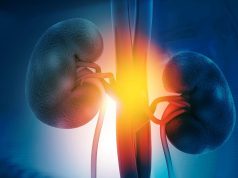Risk for progression to composite outcome did not differ across age groups for patients with MCD, FSGS, and MN
By Elana Gotkine HealthDay Reporter
WEDNESDAY, Nov. 12, 2025 (HealthDay News) — For patients with primary glomerular diseases, young patients face similar risks of kidney function decline as older patients, according to a study presented at Kidney Week, the annual meeting of the American Society of Nephrology, held from Nov. 5 to 9 in Houston.
Margaret Helmuth, from the University of Michigan in Ann Arbor, and colleagues compared disease outcomes among patients with minimal change disease (MCD), focal segmental glomerulosclerosis (FSGS), membranous nephropathy (MN), and immunoglobulin A nephropathy (IgAN) across the lifespan. The cohort included 2,915 patients (647 with MCD, 738 with FSGS, 636 with MN, and 894 with IgAN), with a median follow-up of 5.6 years.
The researchers found that pediatric patients with MCD had steeper declines in estimated glomerular filtration rate (eGFR) than adults (–0.6 to –1.3 versus –0.4 to +0.5 mL/min/1.73 m2), while among their diagnosis cohorts, the steepest declines in eGFR were seen for patients with MN aged 13 to 17 years and for patients with FSGF and IgAN aged 18 to 44 years, respectively. The risk for progression to the composite outcome of death, end-stage kidney disease, or ≥40 percent eGFR decline did not differ in the various age groups for patients with MCD, FSGS, and MN, while the risks for progression were lower for patients with IgAN aged 6 to 12, 13 to 17, and 45 to 64 years compared with those aged 18 to 44 years (hazard ratios, 0.33, 0.44, and 0.64, respectively).
“These findings suggest that young patients who obtained a kidney biopsy diagnosis of primary glomerular disease face significant risk of reaching kidney failure and requiring dialysis and/or a transplant in their lifetimes,” Helmuth said in a statement.
Copyright © 2025 HealthDay. All rights reserved.








